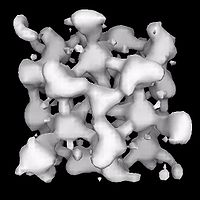
Electride
Encyclopedia

Chemical compound
A chemical compound is a pure chemical substance consisting of two or more different chemical elements that can be separated into simpler substances by chemical reactions. Chemical compounds have a unique and defined chemical structure; they consist of a fixed ratio of atoms that are held together...
in which an electron
Electron
The electron is a subatomic particle with a negative elementary electric charge. It has no known components or substructure; in other words, it is generally thought to be an elementary particle. An electron has a mass that is approximately 1/1836 that of the proton...
is the anion. The first electrides to be studied in depth were solutions of alkali metal
Alkali metal
The alkali metals are a series of chemical elements in the periodic table. In the modern IUPAC nomenclature, the alkali metals comprise the group 1 elements, along with hydrogen. The alkali metals are lithium , sodium , potassium , rubidium , caesium , and francium...
s in ammonia
Ammonia
Ammonia is a compound of nitrogen and hydrogen with the formula . It is a colourless gas with a characteristic pungent odour. Ammonia contributes significantly to the nutritional needs of terrestrial organisms by serving as a precursor to food and fertilizers. Ammonia, either directly or...
. When sodium metal dissolves in ammonia, the result is a blue solution consisting of [Na(NH3)6]+ and solvated electron
Solvated electron
A solvated electron is a free electron in a solution. Solvated electrons occur widely although they are often not observed directly. The deep colour of solutions of alkali metals in ammonia arises form the presence of solvated electrons: blue when dilute and copper-colored when more concentrated...
s. Such solutions are powerful reducing agent
Reducing agent
A reducing agent is the element or compound in a reduction-oxidation reaction that donates an electron to another species; however, since the reducer loses an electron we say it is "oxidized"...
s, as demonstrated by their use in the Birch reduction
Birch reduction
The Birch Reduction is an organic reaction which is particularly useful in synthetic organic chemistry. The reaction was reported in 1944 by the Australian chemist Arthur Birch working in the Dyson Perrins Laboratory in the University of Oxford, building on earlier work by Wooster and Godfrey in...
. Evaporation of these blue solutions affords a mirror of Na. Such solutions slowly lose their colour as the electrons reduce ammonia:
- [Na(NH3)6]+e− + NH3 → NaNH2Sodium amideSodium amide, commonly called sodamide, is the chemical compound with the formula NaNH2. This solid, which is dangerously reactive toward water, is white when pure, but commercial samples are typically gray due to the presence of small quantities of metallic iron from the manufacturing process...
+ H2
Addition of 2,2,2-cryptand
2.2.2-Cryptand
2,2,2-Cryptand is one of the most important members of the cryptand family of chelating agents.In Nomenclature of Inorganic Chemistry , IUPAC recommends the abbreviation "crypt-222"....
to a solution of [Na(NH3)6]+e− affords [Na(2,2,2-crypt)]+e−. Evaporation of these solutions yields a blue-black paramagnetic salt with the formula [Na(2,2,2-crypt)]+e−. Such salts decompose above 240 K, though [Ca24Al28O68]4+(e-)4 is stable at room temperature. In these salts, the electron is delocalized between the cations. Electrides are paramagnetic
Paramagnetism
Paramagnetism is a form of magnetism whereby the paramagnetic material is only attracted when in the presence of an externally applied magnetic field. In contrast with this, diamagnetic materials are repulsive when placed in a magnetic field...
and Mott insulator
Mott insulator
Mott insulators are a class of materials that should conduct electricity under conventional band theories, but are insulators when measured...
s.
There is strong theoretical evidence for electride behaviour in the newly discovered insulating high-pressure forms of sodium and lithium.

